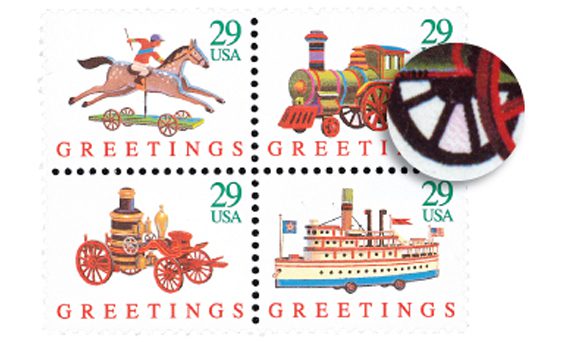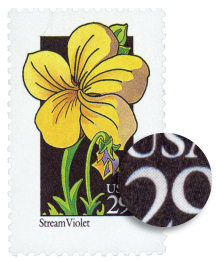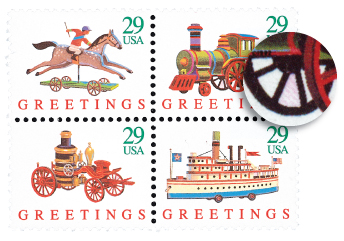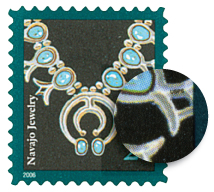What is microprinting?
Maybe you’ve heard the word Microprinting but you’re not sure what it is. Microprinting is tiny type added to a stamp’s design. The type is so small, it can’t be read without a magnifying glass or microscope. The printing is usually made up of letters, numbers, and symbols.
Microprinting is a security measure to prevent counterfeiting. The use of counterfeited stamps means lost revenue for the U.S. Postal Service. Producing and selling fake stamps is a federal crime.
When forgers try to reproduce a microprinted stamp using a scanner or photocopier, the text may appear as a solid line or blur. It’s too small to make a clear copy.
You’ll need a magnifying glass with at least 4x magnification to see the microprinting on your stamps. (See our 3” acrylic dome magnifier here. Or for portable convenience and greater magnification, get our 10X folding magnifier with built in LED light offered here.)
The first stamp to be microprinted was U.S. #2655, the 1992 Stream Violet stamp. If you look closely at the 29¢ denomination, you’ll see shading made by microscopic dots.
The first stamps with microprinting in the design were the 1992 Christmas Toys stamps (#2711-14). In these stamps, portions of the wheels are shaded with magenta dots.
More recent microprinting uses a combination of letters and numbers such as: USPS, 4eveR, 4evr, or 4EVR.
The microprinting on US #3752 is located on the end of the second squash blossom on the right side of the necklace. The photo on the right shows the section under magnification.
The microprinting on #3314 is on the upper right petal of the flower. It spells out the word “BOTANISTS.”






I have over 5000 stamps from all over the world ,some are mint some are used ive had them for 41 years , the binders where burnt around the edges ,the stamps were not harmed, I was 14 when I found them in a fire my father was cleaning up. How do I go about getting an estament for them??
Although Mystic Stamp Company doesn’t perform appraisals, we can recommend several reliable sources for information. For example, the Scott Catalogue is filled with information on U.S. stamps and most worldwide issues. Another source for worldwide stamps is the Kraus-Minkus Catalog. Both catalogs are great resources for stamp identification and value. Most local libraries contain at least one of these valuable resources.
Thank you for this information. I have many stamps of which I had no idea of the value. I hope this helps me!